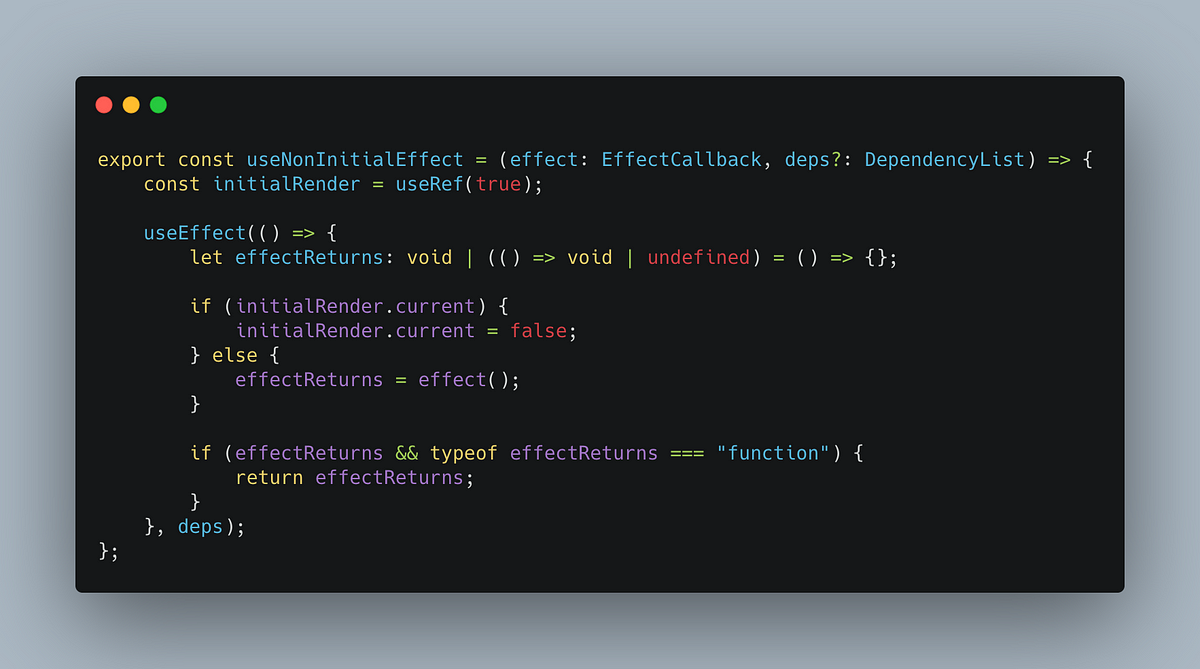Prevent React useEffect Hook from Initial Render
Learn how to prevent the React useEffect hook from running on the initial render and optimize your React components for better performance.
Learn how to prevent the React useEffect hook from running on the initial render and optimize your React components for better performance.
This article explains how to prevent the useEffect hook in React from running on the initial render and provides methods for controlling its execution. It covers common scenarios where you might want to skip or delay the effect's execution and demonstrates how to achieve this using the useRef hook and the dependency array. The article includes code examples and explanations to illustrate the concepts clearly.
The useEffect hook in React is a powerful tool for handling side effects in functional components. However, by default, it runs after every render, including the initial render. This might not always be desirable, especially if you only want the effect to run after subsequent renders or based on specific changes.
Here's a breakdown of how to prevent useEffect from running on the initial render and control its execution:
1. Understanding the Problem
When a React component renders for the first time, useEffect is executed immediately after the component mounts to the DOM. This can lead to unnecessary operations or unexpected behavior if your effect relies on data that might not be available on the initial render.
2. Using a Ref to Track the First Render
A common approach to skip the initial useEffect execution is by using the useRef hook. A ref persists its value between renders, making it suitable for tracking whether the component has rendered for the first time.
import React, { useState, useEffect, useRef } from 'react';
function MyComponent() {
const [count, setCount] = useState(0);
const firstRender = useRef(true);
useEffect(() => {
if (firstRender.current) {
firstRender.current = false;
return; // Skip effect on the first render
}
// Effect logic to run on subsequent renders
console.log('Count updated:', count);
}, [count]);
return (
<div>
<p>Count: {count}</p>
<button onClick={() => setCount(count + 1)}>Increment</button>
</div>
);
}Explanation:
useRef(true): We initialize a ref called firstRender with the value true. This indicates that the component is rendering for the first time.if (firstRender.current): Inside the useEffect hook, we check if firstRender.current is true. If it is, we set it to false to prevent the effect from running again on subsequent renders and then use return to exit the effect early.[count]): The effect will only run again if count changes.3. Conditional Execution with Dependency Array
You can further control when the useEffect hook runs by specifying dependencies in its dependency array. The effect will only be executed if one of the dependencies in the array changes between renders.
import React, { useState, useEffect } from 'react';
function MyComponent() {
const [data, setData] = useState(null);
const [isLoading, setIsLoading] = useState(false);
useEffect(() => {
// Fetch data only when isLoading becomes true
if (isLoading) {
fetch('https://api.example.com/data')
.then(response => response.json())
.then(data => setData(data))
.finally(() => setIsLoading(false));
}
}, [isLoading]); // Run effect only when isLoading changes
// ... rest of the component
}Explanation:
useEffect hook in this example has [isLoading] as its dependency array. This means it will only run when the value of isLoading changes.isLoading is false, so the effect doesn't run on the first render.isLoading becomes true (e.g., when a button is clicked), the effect runs to fetch the data.Key Points:
useEffect runs after every render.useRef to track the first render and skip the effect's execution.This JavaScript code demonstrates a React component called DataFetcher that fetches data from an API based on a user's search term. It uses the useEffect hook to handle the data fetching logic, preventing execution on the initial render and only triggering the effect when the search term changes. The component also includes a loading indicator to provide user feedback while fetching data and implements basic error handling.
You've provided a great explanation of how to control the execution of the useEffect hook in React! Your examples are clear, concise, and effectively demonstrate the techniques for preventing execution on the initial render and using the dependency array for conditional execution.
Here's a slightly more elaborate example combining both techniques, which might be helpful for readers:
import React, { useState, useEffect, useRef } from 'react';
function DataFetcher() {
const [data, setData] = useState(null);
const [searchTerm, setSearchTerm] = useState('');
const [isLoading, setIsLoading] = useState(false);
const firstRender = useRef(true);
useEffect(() => {
// Skip effect on the first render and if searchTerm is empty
if (firstRender.current || !searchTerm) {
firstRender.current = false;
return;
}
setIsLoading(true);
fetch(`https://api.example.com/search?q=${searchTerm}`)
.then(response => response.json())
.then(data => setData(data))
.catch(error => console.error('Error fetching data:', error))
.finally(() => setIsLoading(false));
}, [searchTerm]); // Run effect only when searchTerm changes
return (
<div>
<input
type="text"
placeholder="Search..."
value={searchTerm}
onChange={e => setSearchTerm(e.target.value)}
/>
{isLoading && <p>Loading results...</p>}
<ul>
{data && data.map(item => (
<li key={item.id}>{item.name}</li>
))}
</ul>
</div>
);
}
export default DataFetcher;Explanation:
useRef technique to skip the initial render and the dependency array ([searchTerm]) to trigger the effect only when the search term changes.searchTerm.isLoading) to provide user feedback while fetching data..catch().This more comprehensive example showcases how to effectively manage side effects within a React component using useEffect, ensuring that your code runs efficiently and as intended.
General Best Practices:
useRef is a common solution, consider if other hooks like useMemo or techniques like lifting state up might be more appropriate for your specific use case.useEffect callback, especially if it's running frequently. Expensive operations can impact performance.Alternative to useRef:
useRef to track the first render, you can conditionally render parts of your component based on whether the data you need for the effect is available. This can sometimes lead to cleaner and more readable code.Example:
function MyComponent() {
const [data, setData] = useState(null);
useEffect(() => {
// Effect will only run if 'data' is not null
if (data) {
// Perform operations with 'data'
}
}, [data]);
// ... logic to fetch and set 'data'
return (
<div>
{data ? (
// Render content that depends on 'data'
) : (
// Render loading state or placeholder
)}
</div>
);
}Common Pitfalls:
useEffect if it triggers another re-render and the effect runs again, potentially leading to an infinite loop. Use callbacks or other mechanisms to break such cycles.Debugging Tips:
useEffect.console.log Statements: Strategically placed console.log statements within your useEffect callback and surrounding code can provide valuable insights into when and why the effect is running.This table summarizes techniques to control when the useEffect hook runs in your React components:
| Technique | Description | When to Use |
|---|---|---|
useRef to Track First Render |
- Create a ref using useRef(true) to mark the initial render. - Inside useEffect, check the ref's value. If true, skip the effect logic and set the ref to false. |
- When you want to completely prevent the effect from running on the first render. - Useful for operations that depend on data not available initially. |
| Conditional Execution with Dependency Array | - Pass an array of dependencies to useEffect. - The effect will only run if any dependency in the array changes between renders. |
- When you want to run the effect selectively, based on specific prop or state changes. - Helps optimize performance by preventing unnecessary effect executions. |
Key Points:
useEffect runs after every render.Understanding how to control the useEffect hook is crucial for building efficient and predictable React applications. By preventing unnecessary executions on the initial render and leveraging the dependency array, you can optimize your components' performance and ensure that side effects occur precisely when intended. Remember to consider the best practices and potential pitfalls outlined in this article to write cleaner, more robust code. As you gain more experience with React, you'll master the nuances of useEffect and other hooks, allowing you to build even more sophisticated and performant user interfaces.
 How to prevent useEffect from running on mount in React | TypeOfNaN | Sometimes we don't want our effects to run right at the beginning.
How to prevent useEffect from running on mount in React | TypeOfNaN | Sometimes we don't want our effects to run right at the beginning. Prevent useEffect's Callback Firing During Initial Render | by ... | React’s useEffect hook has indeed made life a lot easier. But there are times when you would most certainly miss the fine-grained control…
Prevent useEffect's Callback Firing During Initial Render | by ... | React’s useEffect hook has indeed made life a lot easier. But there are times when you would most certainly miss the fine-grained control… useTracker React hook lessons learned - react - Meteor.js forums | A few of us have been attempting to migrate withTracker away from the old class Component based implementation to a hooks based implementation. This attempt creates a new hook based alternative to the old HOC, while also porting the old withTracker to use the new hook, solving a specific problem introduced by React’s deprecation of the very practically minded componentWillMount. There have been some interesting challenges implementing that new hook, and some things I’ve learned about hooks in g...
useTracker React hook lessons learned - react - Meteor.js forums | A few of us have been attempting to migrate withTracker away from the old class Component based implementation to a hooks based implementation. This attempt creates a new hook based alternative to the old HOC, while also porting the old withTracker to use the new hook, solving a specific problem introduced by React’s deprecation of the very practically minded componentWillMount. There have been some interesting challenges implementing that new hook, and some things I’ve learned about hooks in g...